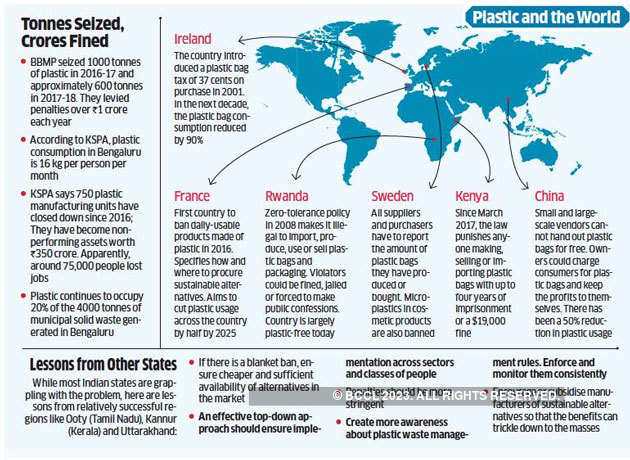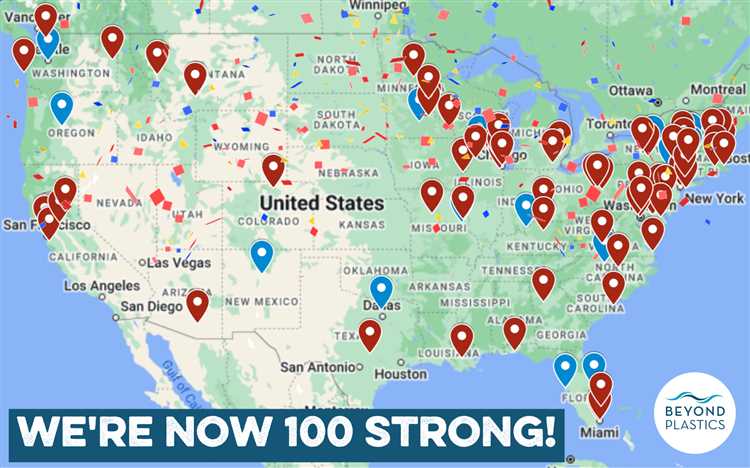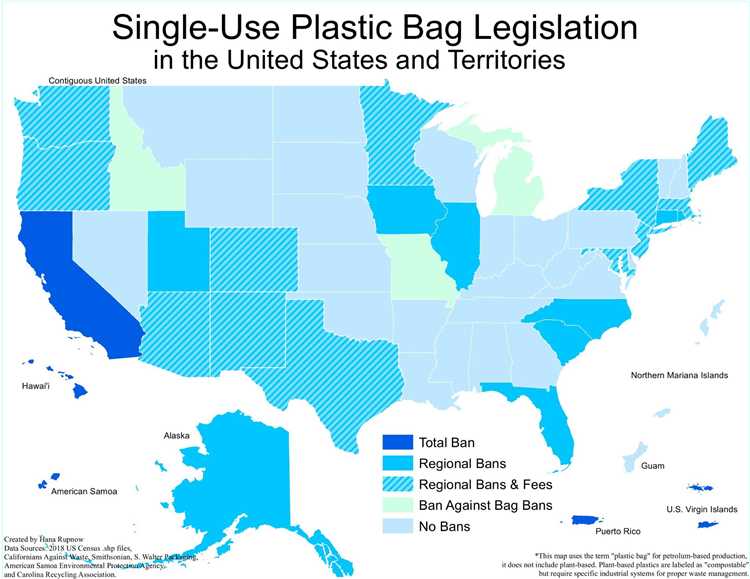
In recent years, environmental awareness has become a pressing global issue, and many states in America have taken significant steps towards reducing plastic waste. Plastic pollution poses a serious threat to our ecosystems, wildlife, and ultimately, human health. As a result, numerous states have implemented regulations and initiatives to promote a plastic-free environment.
One state leading the charge is California. Known for its progressive policies, California banned single-use plastic bags in 2014, becoming the first state to do so. Since then, the ban has been expanded to include larger reusable bags, encouraging residents to bring their own bags when shopping. Additionally, California has implemented stringent recycling programs, and many cities have enforced plastic straw bans, further reducing the state’s plastic footprint.
Oregon is another state that has made substantial efforts in becoming plastic-free. The state has a robust bottle return program, where residents can return used glass, plastic, and aluminum containers for cash. This initiative has proven successful, with a high return rate of containers, reducing litter and promoting recycling. Furthermore, Oregon has implemented measures to ban single-use plastic bags in certain cities, encouraging residents to opt for reusable alternatives.
Washington State is also making significant strides towards a plastic-free future. The state has enacted strict regulations on retailers, prohibiting the distribution of single-use plastic bags. In addition, Washington has implemented a statewide ban on plastic straws and utensils, envisioning a restaurant industry that embraces sustainable alternatives. These initiatives, coupled with ongoing efforts to promote recycling and waste reduction, highlight Washington’s commitment to a cleaner, greener future.
The journey to a plastic-free society is a collective effort, and these states are leading the way. By implementing forward-thinking policies, promoting recycling, and encouraging the use of sustainable alternatives, California, Oregon, and Washington are setting an example for the rest of the country. It is crucial for other states and communities to follow suit in order to protect our planet for future generations.
- Environmental Initiatives in the Greenest States
- Plastic Bans: The Road Towards a Greener Future
- Innovative Solutions: Plastic Alternatives and Recycling Programs
- Positive Impacts: How Plastic-Free States Benefit the Environment
- 1. Reduced Plastic Waste
- 2. Decreased Pollution
- 3. Protection of Marine Life
- Challenges and Obstacles: Overcoming Plastic Pollution
- Inspiring Examples: Leading the Way towards a Plastic-Free America
- Q&A:
- Which states in America have made the most progress in becoming plastic-free?
- What are the measures being taken by these states to reduce plastic usage?
- How effective have these measures been in reducing plastic waste?
- Are there any challenges faced by these states in their efforts to become plastic-free?
- What can other states learn from the plastic-free states in America?
Environmental Initiatives in the Greenest States

When it comes to environmental initiatives, some states in America stand out as leaders in sustainable practices and reducing their carbon footprint. These states are constantly innovating and implementing green strategies to protect and preserve the environment. Let’s explore some of the environmental initiatives in the greenest states.
| State | Initiative |
|---|---|
| California | California has been a pioneer in environmental initiatives, implementing policies to reduce greenhouse gas emissions and promote renewable energy. The state has set ambitious goals to achieve 100% clean energy by 2045 and has implemented various programs to encourage electric vehicle adoption and energy efficiency. |
| Oregon | Oregon has taken significant steps to protect its natural resources. The state has a strong commitment to renewable energy, with a goal to have 50% of its electricity come from renewable sources by 2040. Oregon has also implemented programs to reduce waste, promote recycling, and protect its forests through sustainable forest management practices. |
| Vermont | Known for its picturesque landscapes, Vermont has prioritized sustainable practices. The state has set a goal to transition to 90% renewable energy by 2050 and has implemented policies to promote energy efficiency and conservation. Vermont is also actively working to reduce greenhouse gas emissions and promote sustainable transportation options. |
| Washington | Washington state has made significant investments in clean energy and sustainability. The state has set a goal to eliminate coal-fired electricity by 2025 and achieve 100% clean energy by 2045. Washington has also implemented programs to promote energy efficiency, reduce emissions from transportation, and protect its marine and terrestrial ecosystems. |
| Massachusetts | Massachusetts is known for its commitment to environmental stewardship. The state has set ambitious goals to reduce greenhouse gas emissions, increase renewable energy production, and promote energy efficiency. Massachusetts has implemented various programs to support clean energy development, reduce waste, and improve air and water quality. |
These greenest states are leading the way in environmental initiatives and setting an example for the rest of the country. Through their commitment to sustainability and innovation, they are working towards a cleaner and greener future for all.
Plastic Bans: The Road Towards a Greener Future
Plastic pollution has become a global environmental crisis, with the United States being one of the largest contributors to the problem. However, many states in America are taking proactive steps towards reducing single-use plastics and tackling this issue head-on.
One of the most effective solutions to combat plastic pollution is implementing plastic bans. These bans restrict or outright prohibit the use of certain types of single-use plastics, encouraging individuals and businesses to find alternative, more sustainable options.
Plastic bag bans have been particularly successful in many states. By prohibiting the use of plastic bags in grocery stores and retail establishments, states have been able to significantly reduce the amount of plastic waste generated. This not only helps protect wildlife and marine ecosystems but also encourages the use of reusable bags, which are more durable and eco-friendly.
In addition to plastic bag bans, some states have also implemented bans on other single-use plastics, such as straws and plastic utensils. These bans encourage individuals to use alternatives like metal or bamboo straws and biodegradable utensils, which are more environmentally friendly and less harmful to wildlife.
Furthermore, some states have taken an even more comprehensive approach by banning polystyrene foam, commonly known as Styrofoam. This material is notorious for being non-biodegradable and difficult to recycle, often ending up in landfills or as litter. By banning the use of Styrofoam food containers and packaging materials, states are promoting the use of more sustainable alternatives like paper or compostable materials.
Plastic bans are not only beneficial for the environment but also for local economies. By encouraging the use of eco-friendly alternatives, states are fostering the growth of businesses that produce and sell these products. This creates jobs and stimulates local economies while also protecting the environment.
While plastic bans alone may not solve the plastic pollution crisis, they are an essential step towards a greener future. By reducing our reliance on single-use plastics, we can significantly decrease the amount of plastic waste that ends up in our oceans, rivers, and landfills.
It is encouraging to see many states in America taking the initiative to implement plastic bans and promote more sustainable practices. However, there is still much work to be done. Continued education, advocacy, and collaboration between states are crucial in the fight against plastic pollution and creating a greener future for all.
Innovative Solutions: Plastic Alternatives and Recycling Programs
As the negative environmental impact of plastic becomes more widely known, states across the country are implementing innovative solutions to reduce and eliminate plastic use. One such solution is the adoption of plastic alternatives.
Plastic alternatives include various materials such as paper, cardboard, glass, and biodegradable materials that can be used instead of single-use plastics. Many states are encouraging businesses and consumers to switch to these alternatives by offering incentives and promoting their benefits.
In addition to promoting plastic alternatives, states are also implementing robust recycling programs. Recycling helps to keep plastic waste out of landfills and reduces the need for new plastic production. These programs often include curbside recycling pickup, recycling centers, and education campaigns to inform residents about proper recycling practices.
Some states have taken their recycling programs a step further by implementing bottle deposit programs. These programs require consumers to pay a small fee when purchasing beverages in plastic bottles, which can be redeemed when the bottles are returned for recycling. This incentivizes consumers to participate in recycling and helps to increase overall recycling rates.
Furthermore, states are investing in research and development of new recycling technologies to solve the challenges associated with recycling certain types of plastics. These technologies aim to increase the efficiency and effectiveness of recycling processes, making it easier to recycle a wider range of plastic materials.
Overall, states in America are taking proactive measures to address the plastic waste issue through the adoption of plastic alternatives and the implementation of comprehensive recycling programs. By promoting these innovative solutions, they are working towards a more sustainable future and setting an example for other states and countries to follow.
Positive Impacts: How Plastic-Free States Benefit the Environment
Plastic-free states play a crucial role in preserving and protecting the environment. By reducing the use of plastic products and promoting sustainable alternatives, these states contribute to the overall effort of mitigating the negative impacts of plastic pollution.
1. Reduced Plastic Waste
A significant benefit of plastic-free states is the reduction of plastic waste. By implementing strict regulations on single-use plastics and promoting reusable alternatives, these states help decrease the amount of plastic that ends up in landfills, oceans, and natural habitats. This reduction in plastic waste reduces the strain on ecosystems and helps maintain the balance of delicate ecosystems.
2. Decreased Pollution
Plastic pollution poses a serious threat to our environment, as it can take hundreds of years to decompose, releasing harmful chemicals in the process. Plastic-free states actively work towards reducing plastic pollution by encouraging the use of eco-friendly alternatives, thereby decreasing the pollution levels in the air, water, and soil. This leads to a cleaner and healthier environment for both humans and wildlife.
Moreover, by reducing the production and use of plastic, these states contribute to the reduction of greenhouse gas emissions. Plastic production involves the extraction and refining of fossil fuels, resulting in significant carbon dioxide emissions. By embracing plastic-free initiatives, states can combat climate change and work towards a greener future.
3. Protection of Marine Life
The excessive use of plastic has devastating effects on marine life. Plastic-free states, by promoting eco-friendly alternatives and reducing plastic waste, play a crucial role in protecting marine ecosystems. Marine animals often mistake plastic debris for food, resulting in ingestion and entanglement, which can be lethal. By reducing plastic pollution, plastic-free states help safeguard diverse marine species and preserve the fragile ocean ecosystems.
In conclusion, plastic-free states make a positive impact on the environment by reducing plastic waste, decreasing pollution levels, and protecting marine life. Their efforts contribute to a more sustainable and eco-friendly future, benefiting both current and future generations.
Challenges and Obstacles: Overcoming Plastic Pollution

Persistent and widespread plastic pollution presents numerous challenges that must be overcome to achieve a plastic-free society. These challenges encompass various aspects of our daily lives and require collective efforts to find sustainable solutions.
1. Plastic Consumption: One of the greatest obstacles in overcoming plastic pollution is excessive plastic consumption. Single-use plastics, such as bags, bottles, and straws, contribute to the majority of plastic waste. Changing consumption patterns and reducing reliance on single-use plastics is crucial.
2. Lack of Awareness: Many individuals are still unaware of the devastating impacts of plastic pollution on the environment and human health. Raising awareness through educational campaigns, media, and advocacy is essential to drive behavioral change and motivate people to adopt plastic-free alternatives.
3. Limited Recycling Infrastructure: Inadequate recycling infrastructure is a significant hurdle in addressing plastic pollution. Insufficient facilities, inefficient processes, and lack of funding hinder the recycling of plastic waste. Expanding and improving recycling systems is necessary to ensure proper disposal and management of plastic waste.
4. Plastic Packaging: The excessive use of plastic packaging in industries such as food, retail, and e-commerce contributes to plastic pollution. Encouraging businesses to adopt sustainable packaging alternatives and promoting the use of biodegradable materials can help reduce plastic waste in these sectors.
5. Microplastics: Microplastics, tiny plastic particles that pollute the environment, pose a significant challenge due to their ubiquity and potential harm to ecosystems and wildlife. Developing effective methods to detect, prevent, and remove microplastics from water bodies and the environment is crucial.
6. Policy and Regulation: In the absence of comprehensive policies and regulations, controlling plastic pollution becomes difficult. Governments, at all levels, need to implement strict regulations, including plastic bans, extended producer responsibility schemes, and incentives for sustainable alternatives.
7. Cultural and Behavioral Change: Transforming societal attitudes and behaviors towards plastic consumption is essential. It requires fostering a culture of sustainability, promoting responsible consumer choices, and encouraging individuals to prioritize long-term environmental well-being over convenience.
8. Plastic in the Ocean: Plastic pollution in the world’s oceans is a global challenge. Removing existing plastic debris from oceans and preventing further pollution requires international cooperation, innovative cleanup technologies, and effective waste management strategies.
Overcoming these challenges requires collective efforts from individuals, communities, businesses, and governments. By adopting sustainable practices, promoting innovation, and enforcing regulations, we can work together to create a cleaner and plastic-free future.
Inspiring Examples: Leading the Way towards a Plastic-Free America
As the movement towards a plastic-free America gains momentum, several states have emerged as leaders in the fight against plastic pollution. These states have implemented innovative strategies and policies to reduce their plastic footprint and inspire change in other parts of the country.
California, for example, has been at the forefront of the battle against plastic pollution. In 2014, the state became the first in the nation to ban single-use plastic bags. This groundbreaking policy has been instrumental in reducing plastic waste and encouraging the use of reusable bags among consumers.
Another state making significant progress is Oregon. The city of Portland has introduced a bag ban and a plastic straw ban, demonstrating its commitment to reducing plastic pollution. Additionally, many businesses in the city have embraced sustainable practices, such as using compostable containers and offering paper straws.
Hawaii is also leading the way towards a plastic-free future. The state has banned the sale and distribution of plastic bags, foam food containers, and plastic utensils. In addition, several Hawaiian islands have implemented successful plastic bottle bans, encouraging residents and visitors to use reusable water bottles instead.
Other states that deserve recognition for their efforts include Vermont, which has implemented a statewide ban on single-use plastic bags, and Washington, which has banned plastic utensils and straws in Seattle. These examples showcase the progress that can be made when states take decisive action to reduce plastic waste.
By highlighting these inspiring examples, we hope to motivate other states and communities across America to take action and join the movement towards a plastic-free future. Together, we can make a significant impact and create a cleaner, healthier environment for future generations.
Q&A:
Which states in America have made the most progress in becoming plastic-free?
Some of the states that have made the most progress in becoming plastic-free include California, Hawaii, and Oregon.
What are the measures being taken by these states to reduce plastic usage?
These states have implemented various measures such as banning single-use plastic bags, implementing bottle deposit programs, and encouraging the use of reusable containers.
How effective have these measures been in reducing plastic waste?
These measures have been quite effective in reducing plastic waste. For example, California’s ban on single-use plastic bags has resulted in a significant decrease in plastic bag litter.
Are there any challenges faced by these states in their efforts to become plastic-free?
Yes, there are several challenges faced by these states. Some of the main challenges include resistance from plastic industry lobbyists and the difficulty of changing consumer behavior.
What can other states learn from the plastic-free states in America?
Other states can learn the importance of implementing legislation to reduce plastic usage, as well as the benefits of promoting reusable alternatives and educating the public about the environmental impact of plastic waste.